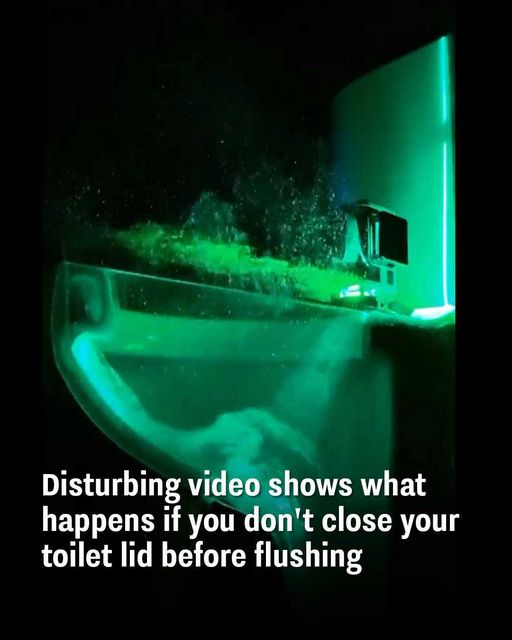Going to the bathroom is a simple routine for most adults. They do their business without thinking about it. In fact, they’d rather not think about it. What happens in the bathroom should stay in the bathroom, right? That is, until a viral video exposed an unfortunate issue that most people never considered. In other words, if you flush the toilet with the lid up, what happens in the toilet does not stay in the toilet.
What really happens when a toilet flushes

Engineers at the University of Colorado Boulder have made a horrible discovery: flushing a commercial toilet sends up a cloud of droplets and aerosol particles over 5 feet into the air. This cloud isn’t visible to the naked eye, but the researchers managed to illuminate it with green lasers. In their video of the experiment, the neon green particles shoot up like out of a confetti gun. Luckily for the researchers, there was only clean water in the toilet bowl. Unfortunately, for everyone else, there are usually less savory things in it.
However, the study published in the journal Scientific Reports only explored the mechanics of toilet flushing. They did not test or examine the particles that could be sprayed into bathrooms. But the fact of the matter is that flushing sends droplets out of the bowl and that itself is disgusting.
“We all were astonished,” said John Crimaldi, the study’s lead author and a professor of hydrology who specializes in fluid mechanics. “I said, ‘Oh, my God — that’s what happens?”
Read More: How to Get Rid of Nasty Toilet Stains – No Scrubbing Required
Why you should always flush with the toilet lid down

His colleague and co-author, Karl Linden, is an environmental engineer. He thought of the idea for this study while brainstorming the best subject to test an ultraviolet-light-based disinfectant. “Where do we get exposed to viruses, and where do we get exposed to pathogens?” Linden said. “And one of the thoughts I had was, ‘Well, what’s happening in toilets?’”
Particularly commercial toilets, like the ones in public washrooms, with no tanks or lids. In North America, these toilets typically use a flushometer-style valve that uses pressure instead of gravity to flush water around the bowl. The result is a tall, invisible mist that hovers in the air for several long moments.
“I have an intuitive sense that the presence of solids might exacerbate the problem because there are just additional things for the water to impinge on and to create more opportunities for this energetic mixing of fluids,” Crimaldi said.
People use this study to advocate for better ways to dispose of human excrement. Until this happens, it’s better to close the toilet lid before flushing. Unfortunately, that isn’t always an option in public bathrooms, but there are several other important etiquette tips to keep in mind.
Don’t linger in public bathrooms

Most people don’t enjoy spending time in public bathrooms, so it’s definitely not the place to socialize or make new friends. If someone comes in while you’re washing your hands, you can give a polite smile or nod of acknowledgement but leave the interaction there. Keep as large a distance as you can between urinals, and don’t hover in front of stalls in use, especially if they have those creepy spaces next to the door that allows people to peek in.
Don’t bother a locked door

If a door is locked, whether it’s a public bathroom or a private residential one, leave it be. Locked means that someone is in there, and continuously knocking and jiggling the doorknob won’t fix that. You can knock once to indicate you’re waiting for your turn, but otherwise step back. No one likes to be pressured while doing their business.
Read More: Your Pillow Case Has More Bacteria Than Your Toilet Seat if You Don’t Wash Your Sheets Often
Lock the door

On the flip side, make sure you lock the door behind you. Not only does it indicate that the room is occupied, but it also prevents any awkward situations. Even if you don’t mind someone accidentally walking in, they probably do mind seeing you in that state. So lock the door and enjoy the privacy.
Only flush toilet-friendly items

Toilets are not built for anything more than human waste and a reasonable amount of toilet paper. So don’t flush sanitary pads, tampons, paper towels, diapers, condoms, wet wipes, “flushable” baby wipes, cigarette butts, gum, cotton balls, Q-tips, plastic, hair, dental floss, napkins, empty toilet paper rolls, or other types of garbage. They may leave the toilet bowl, but they will clump together in the pipes and cause future problems.
Change the toilet paper roll

Leave the bathroom ready for the next person. So clean up after yourself, especially if you took the last bit of toilet paper. No one wants to be left with nothing to wipe with, so make sure another roll is handy. However, people generally can’t refill toilet paper in public restrooms, but if someone is waiting for your stall, warn them there’s no paper left so they can get some from elsewhere.
Wash your hands

Washing your hands goes without saying but it should still be said. As Crimaldi and Linden’s study shows, restrooms may be filthy and ridden with disease-filled bacteria. So don’t take any of that with you when you leave.
